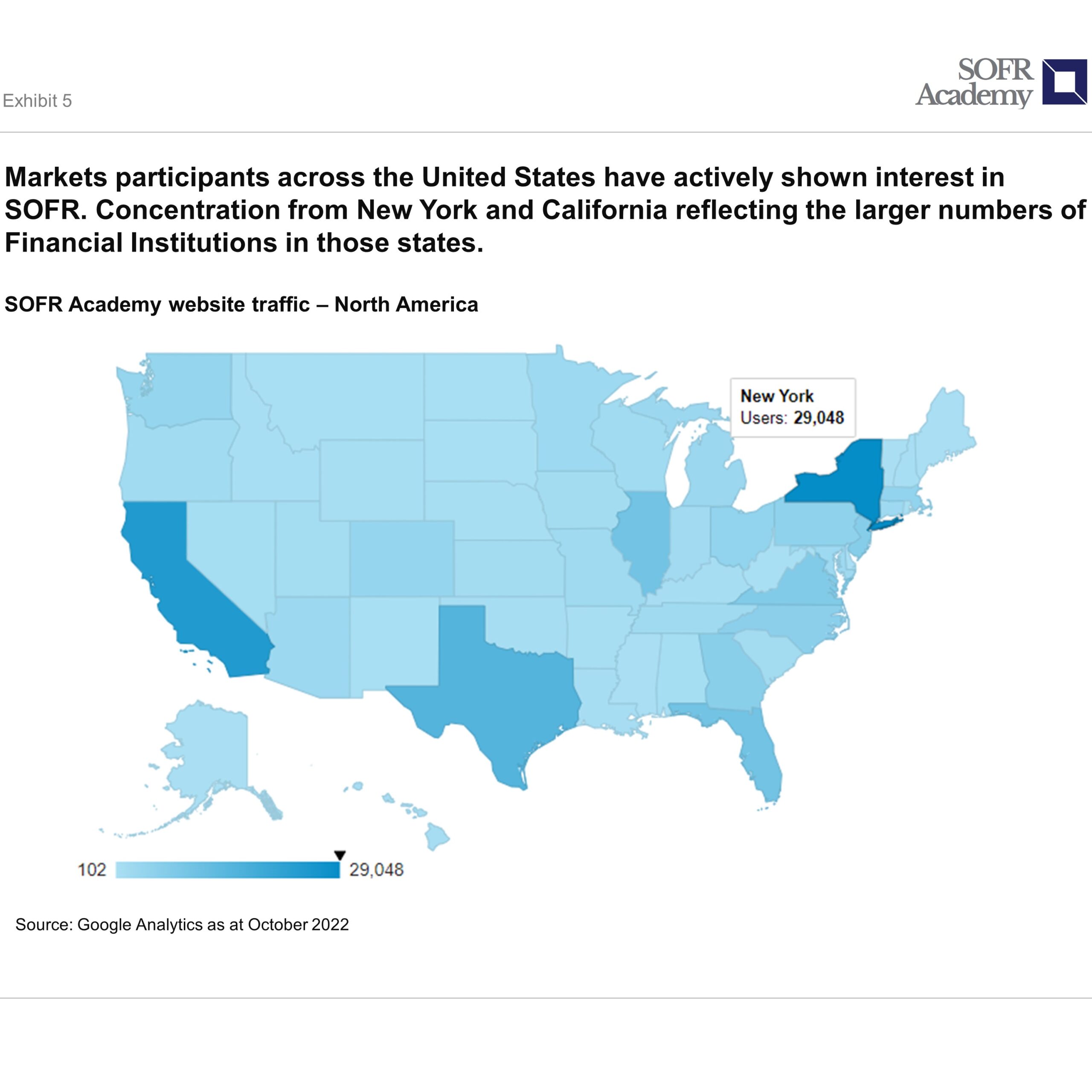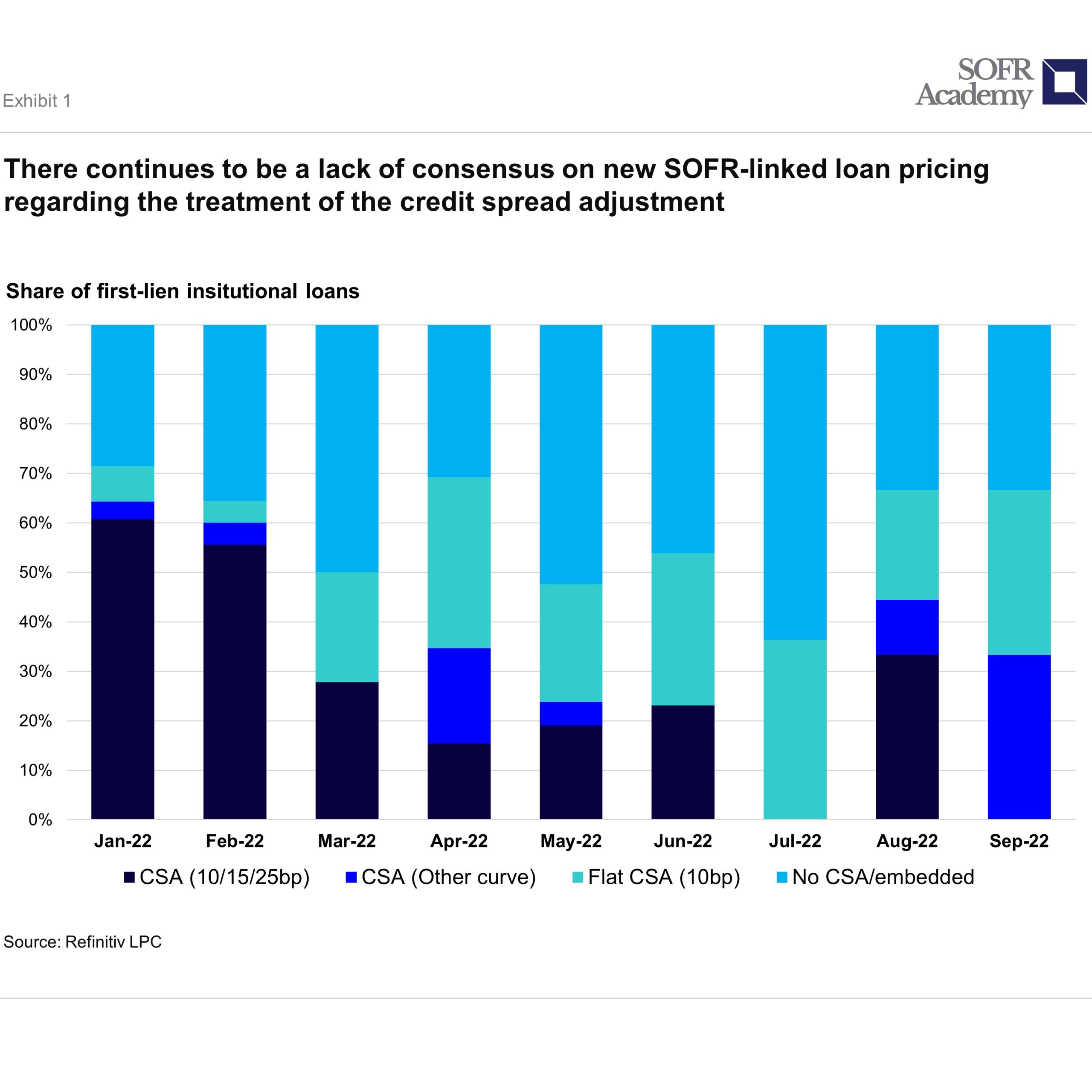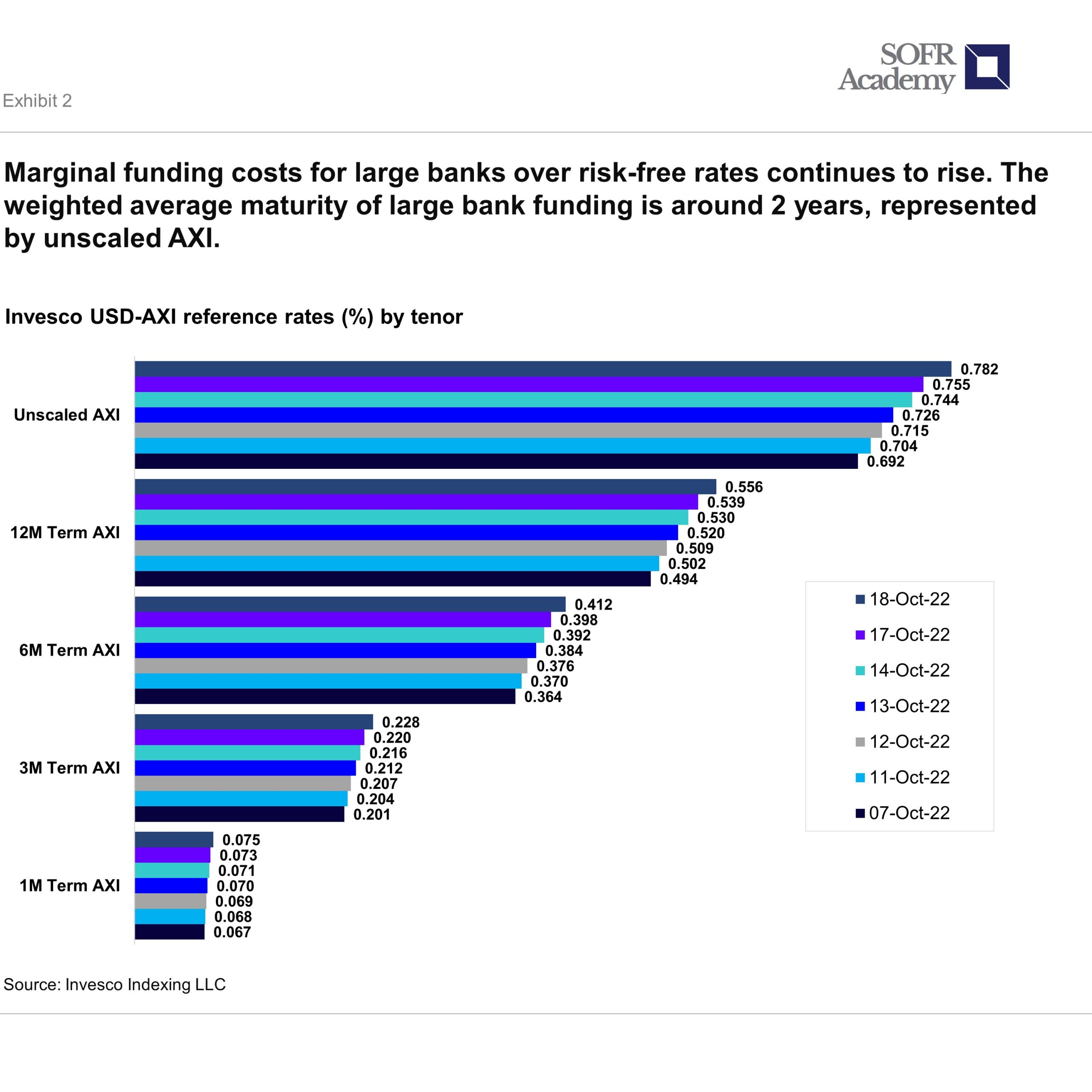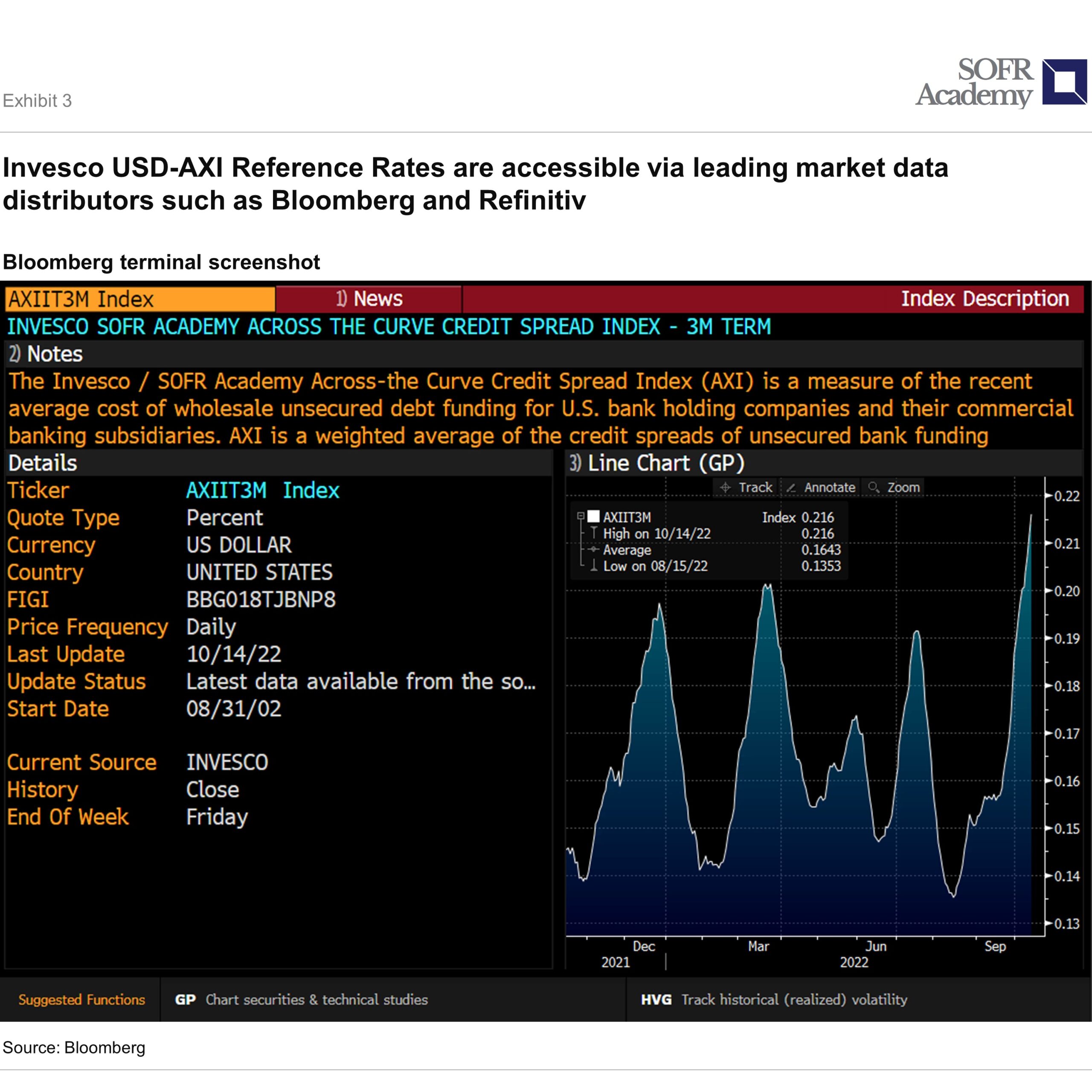Several difficult and diverse macroeconomic challenges facing the global economy today have sharply intensified market focus on credit conditions and funding costs. Many of these challenges stem from Russia’s unlawful war in Ukraine and the continued recovery from the pandemic. Inflation is elevated in many countries. Growth is slowing globally. We are also seeing swings in capital flows and strong movements in financial markets. As stewards of the global reserve currency, the United States has an opportunity and responsibility to take the lead in shaping how credit conditions are quantified and represented in a world without LIBOR.
Recent market forces have renewed focus on credit conditions and marginal funding costs. Lenders and borrowers across the United States are still struggling to coalesce on pricing for new SOFR-based loans which is slowing LIBOR transition in lending markets and increasing risks for US-dollar LIBOR cessation in June 2023. Challenges observed with implementing credit spread adjustments (CSA’s) include ensuring the borrower is treated fairly, to not yet having internal consensus on the bank’s policy for how to account for CSAs, to trying to simply focus on securing a renewal in a competitive market.
“The world is fragile at the moment, it’s uncertain, and we’re operating through that lens”– David Solomon, Goldman Sachs CEO
Lenders are now faced with increases to their marginal cost of funds and contemporaneous market-based spreads have widened due to macroeconomic forces. Licensees of Invesco’s US-dollar across-the-curve credit spread indices (AXI) reference rates can reference AXI as a credit spread supplement in new SOFR loans to improve the accuracy, transparency, fairness and efficiency of their commercial loan pricing. In doing so, lenders can foster better relationships with client borrowers whilst protecting against potential future mismatches between their assets and liabilities. Our observations have revealed the following six advantages of referencing AXI in new SOFR loans:
1. Enhance loan pricing transparency
According to recent loan data from Refinitiv LPC, almost 70% of new SOFR-linked loans written in September 2022 contained some kind of credit spread supplement (see Exhibit 1). The remaining ~30% of loans require the lenders and borrowers to reach an agreement on the incremental margin added to the base rate of the loan. Referencing a credit spread supplement to SOFR such as Invesco AXI in new loans that is independently calculated in a regulated environment enhances loan price transparency for both borrowers and lenders.
The construction of AXI itself also promotes transparency because it stays away from private market transactions including only publicly reported transactions by U.S. data repositories overseen by the Securities and Exchange Commission (SEC). As a quick reminder, the short end input file for AXI is published each business day by the Depository Trust & Clearing Corporation (DTCC) at approximately 5.30pm EST and the long end input data file is published by Financial Industry Regulatory Authority’s (FINRA) Trade Reporting and Compliance Engine (TRACE) at approximately 7.30pm EST. The spreads are calculated and published the following business day around 9am EST including combinations of AXI with SOFR, referred to as SOFRx. Standardizing the publication time of AXI also promotes the development of a hedging market to facilitate risk-transfer and ISDA has published corresponding Interest Rate Derivatives Definitions accessible via their Benchmarks Hub. AXI and its sister index FXI, which reflects credit conditions across the broader U.S. economy, work to form a credit-sensitive interest rate when used in combination with Term SOFR, Simple Daily SOFR, SOFR compounded in arrears, or SOFR Averages.
2. Improve the efficiency of loan negotiations
The lack of market consensus regarding a credit spread adjustment in new SOFR loans is creating a headwind for new SOFR based lending. We have seen the pace of loan refinancing slow in recent months. For credit agreements that include the ARRC-hardwired fallback language, when replacement occurs, generally LIBOR will be replaced with CME Term SOFR plus the ARRC fixed 5-year historical based spread adjustment. However, for credit agreements that include an amendment approach to LIBOR replacement, do not include LIBOR succession provisions, or are for newly originated loans based on SOFR, the SOFR spread adjustment is now a contentious point of negotiation. This is true not just for the United States, but for many other jurisdictions where wholesale US-dollar loans are prevalent. The spread determination may be a holdup for lenders to shift from originating new loans using LIBOR to using SOFR, which is where AXI can help.
Like to view the latest Invesco AXI rates?
Visit the Invesco / SOFR Academy AXI website >
The ARRC spread adjustments based on the 5-year historical LIBOR-SOFR spreads have not proven popular for new loans, largely due to the material difference to contemporaneous spreads. This spread adjustment is the five-year historical median difference between LIBOR and SOFR and was set on March 5, 2021. It is 11.448 bps for hardwired 1M USD LIBOR contracts falling back to 1M SOFR and 26.161 bps for hardwired 3M USD LIBOR contracts falling back to 3M SOFR. When used in legacy loans, as we have communicated, some concern exists that if the historical fixed spreads differ to market-based credit spreads at the time of LIBOR cessation, this could result in market frictions with significant and avoidable value transfer which could give rise to market confusion and conflicts of interest.
3. Manage balance sheet funding risks
Interest rates are rising at an unprecedented pace in the United States. Geopolitical conflicts and inflation remain top of mind. In addition, many measures of credit conditions and marginal funding costs are also on the rise, including AXI. This means that the value of any credit spread supplement to SOFR today should also be higher than a corresponding adjustment in the first quarter this year.
Indeed, it was concerns expressed by a group of large American regional banks that “the spreads between LIBOR and other risk-free short-term borrowing rates widened reflecting a higher credit risk premium demanded by debt investors” creating a “significant mismatch between bank assets (loans) and liabilities (borrowings)” which formed the genesis of a credit sensitive supplement to SOFR in connection with the transition from LIBOR. Developed in partnership between Invesco Indexing and SOFR Academy, AXI was launched to address this issue.
“It has become very difficult for us to hold the 10-basis point credit spread”– Lender at a large Bank
4. Mitigate conduct risks
Shifting market credit conditions also make the problem of figuring out a “fair” spread to SOFR more difficult for lenders. Borrowers in turn, want to know that they are getting a fair deal. That’s where both the lender and borrower being able to observe and reference a third party credit supplement to SOFR such as Invesco AXI can be helpful. When the notional face value of the loan is in the hundreds of millions of dollars every basis point counts. Market participants are able to view Invesco AXI reference rates for free via Bloomberg (see Exhibit 3), via Refinitiv and also at the Invesco AXI website.
Market based spreads are moving. Indeed, 3-Month USD AXI has increased swiftly in recent weeks from a low of around 13.5 basis points in August to printing above 22 basis points today (see Exhibit 3). Allowing borrowers to view the publicly available price of a credit supplement to SOFR in advance of executing a transaction minimizes conducts risks for the lender and reduces the risks associated with internal bank credit spread supplement policies and procedures.
5. Appease regulatory concerns
Regulators and policymakers have performed a critical role with interest rate benchmark reform over the past decade. Successfully guiding the global market away from LIBOR towards more robust near risk-free reference rates such as SOFR was perhaps one of the most challenging and complex transformations to have occurred in global financial markets in our lifetime. In doing so, they have communicated features of new reference rates that are both desirable and undesirable from their perspective, which are motivated by global financial stability. Banks no longer fund themselves in the short term markets that once underpinned LIBOR. Therefore, a current-market credit-sensitive rate such as LIBOR is no longer feasible. The underlying pool of transactions is not sufficiently deep for heavy use in derivatives market applications.
It is important that new benchmark rates and spreads are underpinned by a sufficiently large pool of transactions – they must stand the test of time and must be able to be reliably computed in all economic conditions. Further, history shows us that banks tend to change the maturity profile and composition of their funding profile over time so it is critical that a credit sensitive supplement to SOFR not be limited to transactions that occur only at the shorter end of the yield curve.
Like to view AXI licensing information?
Please email [email protected] to request licensing documentation >
“LIBOR is no longer tenable as a benchmark index because regulations have induced banks to “term out” most of their unsecured funding to longer maturities. As a result, there is no longer a large enough volume of transactions to make LIBOR sufficiently robust as a benchmark. For the same reason, LIBOR is no longer close to being representative of banks’ actual costs of funds, and will likely soon be discontinued,” (Berndt, Duffie & Zhu, 2020). Taking an across-the curve construction approach to a credit sensitive supplement to SOFR successfully navigates concerns expressed by regulators (see Exhibit 4).
6. Leverage the strong foundation of SOFR
If a loan references AXI, it will also reference SOFR. Therefore the development of the AXI market does not lesson the momentum behind SOFR adoption. AXI reference rates were launched only once deep and sustained SOFR-linked markets had developed, and after advance notification was provided. As our name suggests, SOFR Academy supports SOFR. We will not create a path for banks to skip over SOFR and AXI and FXI will exists only as spread supplements to near risk free rates.

AXI reference rates are appropriate for usage in a wide variety of institutional applications. This includes commercial bank lending applications, related derivatives risk management applications (ISDA swap definitions available), Trade Finance activities, Internal funds transfer pricing. Regulators and other market participants can use AXI as indicators to gauge the funding costs for commercial banks.
Have a question about Invesco AXI?
Please contact us, we would love to hear from you.
Invesco USD-AXI and USD-FXI are calculated daily and published at approximately 9 AM ET, using the prior day’s transaction data. The indices are accessible via market data providers Bloomberg and Refinitiv and are posted publicly on www.invescosofracademyaxi.com. All-in benchmark rates are calculated and published where across-the-curve credit spreads are combined with variations of SOFR, including a variation of SOFR plus AXI (‘SOFRx’) and a variation of SOFR plus FXI (‘SOFRy’).
To request information, submit questions, provide feedback, or view licensing documentation please email [email protected]. Licensing is free for market regulators, development banks and Central banks.
Lastly, AXI can be replicated in certain other currencies to provide consistency in multi-currency loan facilities and allow for the development of cross currency products. We will next turn our attention to Chinese AXI.
SOFR Resources
- ARRC Loan Remediation Survey Results: Survey Results Reflect Encouraging Transition Progress in U.S. Dollar (USD) LIBOR Business Loans
- CME Term SOFR website: Information about CME Term SOFR and daily publication of rates
- SOFR Term Rates Factsheet: A summary of the rationale behind the ARRC’s formal recommendation of forward-looking SOFR Term Rates.
- ARRC LIBOR Legacy Playbook: Guide to Support Transition of Legacy LIBOR Cash Products
Invesco USD-AXI Resources
- Invesco AXI Website: Displays the latest AXI and FXI rates published daily, as well as other materials
- AXI 60-Second Explainer Video: A short YouTube video highlighting AXI’s key features.
- Invesco AXI Presentation for the LSTA: Overview of the key features of AXI including transaction volumes (requires LSTA membership)
- Invesco AXI Methodology document: Provides detailed information on AXI’s construction methodology, governance and maintenance.
- Term SOFR + AXI Concept Credit Agreement: Provides an illustrative example of a credit agreement that references CME Term SOFR + AXI for a syndicated term loan facility denominated in US-Dollars.
ABOUT SOFR ACADEMY
SOFR Academy, Inc. provides digital education and market information to empower corporations, financial institutions, governments, and individuals to make better decisions. The Firm’s panel of advisors includes academics from Harvard University, the University of California Berkeley, New York University, the University of Oxford, London Business School and Tsinghua University, as well as experienced financial services professionals. SOFR Academy is a member of the Asia Pacific Loan Market Association (APLMA), American Economic Association (AEA), the Loan Syndications and Trading Association (LSTA), the International Swaps and Derivatives Association (ISDA), the Bankers Association for Finance and Trade (BAFT) which is a wholly owned subsidiary of the American Bankers Association (ABA), the U.S. Chamber of Commerce (USCC) and the Bretton Woods Committee (BWC). For more information, please visit www.SOFR.org.
DISCLAIMER
The invasion of Ukraine in February 2022 is having deep human, as well as social and economic, impact across countries and sectors. The implications of the invasion are rapidly evolving and are inherently uncertain. As a result, this note, and the data and analysis it sets out, should be treated as a best-efforts perspective at a specific point of time, which seeks to help inform discussion and decisions taken by leaders of relevant organizations. The document does not set out economic or credit conditions forecasts and should not be treated as doing so. It also does not provide legal analysis, including but not limited to legal advice.
This note does not constitute a recommendation of any investment strategy or product for a particular investor. Investors should consult a financial professional before making any investment decisions.
Invesco Indexing LLC is an indirect, wholly owned subsidiary of Invesco Ltd. The group is legally, technologically and physically separate from other business units of Invesco, including the various global investment centers.
SOFR is published by the Federal Reserve Bank of New York (The New York Fed) and is used subject to The New York Fed Terms of Use for Select Rate Data. The New York Fed has no liability for your use of the data. AXI is not associated with, or endorsed or sponsored by, The New York Fed or the Alternative Reference Rates Committee (ARRC).
Darrell Duffie who is The Adams Distinguished Professor of Management and Professor of Finance at Stanford Graduate School of Business, has no equity or financial interest in SOFR Academy, Invesco Indexing LLC or Invesco Ltd.
Any prospective user of AXI or FXI that would intend to also use CME Term SOFR in developing an interest rate for Cash Market Financial Products or OTC Derivative Products would require a license with CME Group for use of CME Term SOFR. AXI is not associated with or sponsored by the CME Group.






